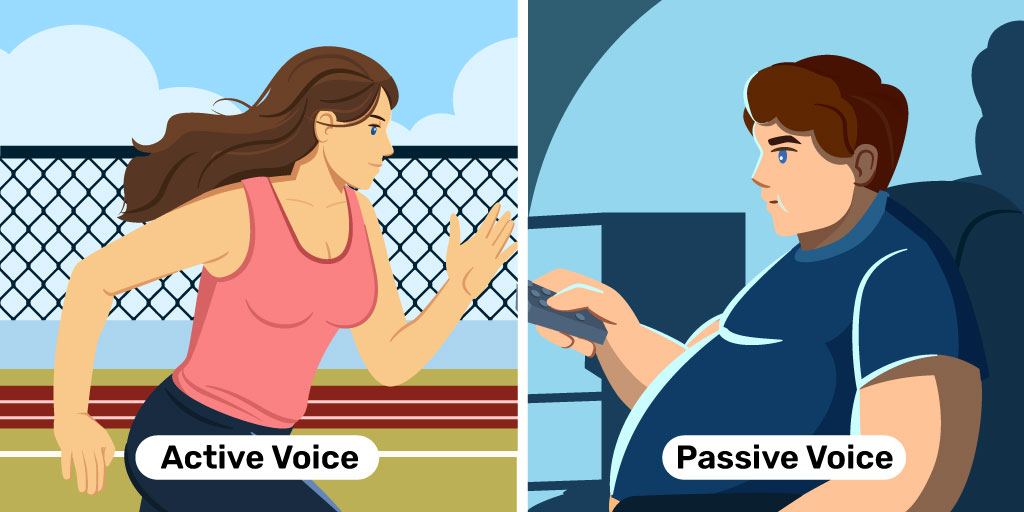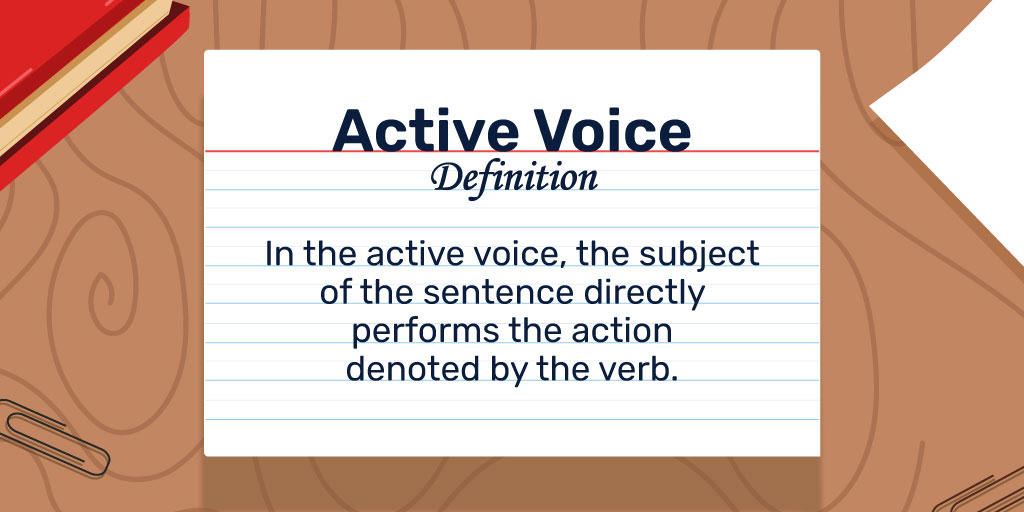Imagine strolling through a story factory. In one room, characters dance and sing vigorously, announcing their actions with noise and pride; this is the realm of the active voice. Across the hall, shadows move mysteriously, and tales unfold with a more elusive allure: welcome to the sanctuary of the passive voice.
As writers, we often hear cautionary tales about these two linguistic forms, urging us to favor one while avoiding the other. But to truly master our craft, it is important to understand both and embrace the unique charm of each. So, join us as we venture deeper into the world of active vs. passive voice, explaining the differences and giving examples along the way.
Active vs. Passive Voice

In sentences written in the active voice, the subject performs the action. The subject is acted upon by an outside person or thing, which is sometimes identified but often omitted.
Active Voice: John (subject) wrote (verb) the poem (object).
Passive Voice: The poem (subject) was written (verb) by John (agent).
In essence, the active voice centers on who or what is performing the action, whereas the passive voice emphasizes the action itself or the recipient of the action.
Let’s look at the differences in the following overview:
Characteristic | Active Voice | Passive Voice |
|---|---|---|
Sentence Structure | Subject as acting agent-Verb-Object | Subject as recipient of the action-Verb-by Agent, if stated |
Subject’s Role | Subject performs the action | Subject is the recipient of the action |
Emphasis | Emphasis on the doer of the action | Emphasis on the action or the recipient of the action |
Clarity | More direct and straightforward | More indirect or ambiguous |
Length | Usually shorter | Usually longer |
Usage | Preferred for most types of writing for clarity | Useful when the doer is unknown, irrelevant, or when the focus is on the action or recipient |
Craft of Writing Quiz (Easy)

What is Active Voice?

In the active voice, the subject of the sentence performs the action expressed by the verb.
The sentence starts with the subject (the acting agent), moves to the verb, and ends with the object.
Active voice offers a straightforward way of structuring information, providing readers with clear insight into who is doing what. It can make a scene or statement feel immediate and dynamic.
The focus remains on the subject—the one taking action—rather than on the action itself or its receiver. As such, it allows characters to take charge of their destinies, showing their motivations and decisions directly.
Active Voice Examples
Most literature, both fiction and nonfiction, is written in the active voice, since it is clearer and shorter. But active voice sentences don’t have to be short or simple, and they often aren’t.
To help us identify different types of active voice sentences, look at the examples below.
Simple Sentences
Look at these simple example sentences from fiction:
- Vaughan (subject) died (verb) yesterday in his last car-crash (object). – J. G. Ballard, “Crash”
- I (subject) write (verb) this sitting in the kitchen sink (object). – Dodie Smith, “I Capture the Castle”
- Winston (subject) was writing (verb) in his diary (object). – George Orwell, “1984”
These are the “The boy kicks the ball” examples that you will find in every grammar guide.
Compound Sentences
But, unless you mostly read first-grade texts, sentences usually aren’t that short and simple. The longer sentences that appear in books typically have more than one verb, each of which can be either active or passive.
Here is a longer sentence with multiple active voice verbs:
- As Gregor Samsa (subject) awoke (verb) one morning from uneasy dreams (object) he (subject) found (verb) himself transformed in his bed into a gigantic insect (object). – Franz Kafka, “The Metamorphosis”
In this sentence, Gregor Samsa is the subject and the one performing the actions: he was the person who both awoke and found. Even though the idea of him being “transformed” might seem passive because something happened to him, the structure of the sentence places Gregor as the active agent of finding himself in that transformed state.
The Effect of Linking Verbs
Many sentences contain something called a linking verb, which is a type of verb that merely shows that something exists or describes how it looks. These include verbs like be/is, become, seem, and appear.
It doesn’t show an action being done by or to the subject in the typical active or passive manner. Accordingly, it doesn’t add an active or passive voice to a sentence.
If it is the only verb, then the sentence is neither active nor passive, as in these examples:
But if a linking verb appears together with a stronger action verb, the sentence inherits its active or passive voice status from the action verb, as in these active voice examples:
- It was (linking verb) a bright cold day in April, and the clocks were striking (active voice verb) thirteen. – George Orwell, “1984”
- It was (linking verb) the day my grandmother exploded (active voice verb). – Iain M. Banks, “The Crow Road”
What is Passive Voice?

In the passive voice, the sentence still starts with the subject. But the subject of the sentence is acted upon by the verb, rather than being its doer.
The sentence starts with the subject being acted upon, moves to the verb, and sometimes finishes with an acting agent.
Passive voice shifts the focus from the doer to the action or receiver of the action. The doer of the action (the agent) can be omitted if it’s unknown or irrelevant.
It typically uses a form of the verb “to be” followed by a past participle. A past participle is a verb form used to indicate a completed action. such as swum, run, drunk, seen, worked, played, and gone.
Passive Voice Examples
There are also different types of sentences in which you can use the passive voice construction. Let’s look at a few examples from literature.
Nonfiction
When authors want to draw their readers’ attention to the action or receiver of the action, they use passive voice sentences. This is very common in scientific write-ups, where the action is more important than the acting agent; in crime reporting, where the perpetrator is unknown; and in political accounts, where writers try to be scrupulously neutral.
In these circumstances, the agent that does the action to the subject is almost always omitted. Consider these examples:
- Adult age-matched mice (subjects) were divided (verb) into intact, sham, or T2DM groups. – General and Comparative Endocrinology, August 22, 2023
- A search of the premises (subject) was immediately made (verb) and a ransom note demanding $50,000 (subject) was found (verb) on the nursery window sill. – FBI’s account of the Lindbergh Kidnapping
- A coalition government (subject) was formed (verb) in Parliament, made up almost entirely of parties linked to the generals who led the last military coup. – New York Times, August 24, 2023
Fiction
But authors of fiction also often want to emphasize actions or events, rather than the agents that do them. Look at these opening sentences of two classic novels:
- The story so far: in the beginning, the universe (subject) was created (verb). – Douglas Adams, “The Restaurant at the End of the Universe”
- “The year 1866 (subject) was signalized (verb) by a remarkable incident, a mysterious and inexplicable phenomenon. – Jules Verne, “Twenty Thousand Leagues Under the Sea”
Douglas Adams didn’t want to specify who created the universe, and Jules Verne wanted to talk about a mysterious apparition, not about its causes.
Active and Passive Voice Blends
Often, sentences with multiple verbs contain both active and passive verb forms.
If one part of the sentence or one of the verbs is clearly more important, the sentence inherits its active or passive voice status from that.
But, in many sentences, all its verbed clauses seem important to their meaning. In those cases, you are dealing with a sentence that is a mixture of active and passive voice.
Here are some examples:
- The story so far: in the beginning, the universe was created (passive voice). This has made a lot of people very angry (active voice) and been widely regarded as a bad move (passive voice). Douglas Adams, “The Restaurant at the End of the Universe”
- When Mary Lennox was sent to Misselthwaite Manor to live with her uncle (passive voice), everybody said she was the most disagreeable-looking child ever seen (active voice). – Frances Hodgson Burnett, “The Secret Garden”
- Decisions are never really made (passive voice) – at best they manage to emerge from a chaos of peeves, whims, hallucinations and all around assholery (active voice). – Thomas Pynchon, “Gravity’s Rainbow”
- She had begun to sense (active voice) that there was a collective, unspoken jury (neutral linking verb) that went into deliberations over every new teacher (active voice), and that the verdict being returned on her was not so good (passive voice). – Stephen King, “The Dead Zone”
Benefits of Using Active Voice

In most circumstances, it is better to use active voice sentence construction, especially when the doer of the action is known.
Active voice offers several benefits, such as the following:
- Clarity and Directness: Because sentences sound more direct and straightforward, active voice makes it easier for readers to understand the main message. Passive voice, in contrast, often deliberately omits information.
- Conciseness: Active voice sentences can be more concise because they usually require fewer words to convey the same message, while passive voice can be very wordy.
- Energetic Writing: In contrast to the roundabout and formal expression of passive voice, active voice gives a feeling of immediacy and can make your writing seem more dynamic and livelier.
- Accountability: Active voice can clearly indicate who did what, making responsibilities and roles clear. On the contrary, because passive voice sometimes obscures the doer of the action, it can seem evasive.
Notwithstanding these benefits, it is a misconception that writers should always avoid passive voice. While it’s true that excessive passive voice can weaken writing, there are instances where it is appropriate or even preferable. For example, in scientific writing where the focus is on the action or result rather than the doer, or in situations where the doer is unknown or irrelevant.
How to Use Active and Passive Voice
In essence, the choice between active and passive voice depends on what you want to emphasize and the context of your writing. Understanding the nuances of each voice can help writers craft more engaging and effective prose.
When to Use Active Voice
Active voice is perfect when you want to highlight the person or thing performing the action. In fiction, it helps your readers to picture the scene vividly in their heads. For example, “Harry caught the golden snitch during the Quidditch match” is upfront about the identity of the person who caught the golden snitch and tells a tale that readers can visualize.
It is also the right choice when clarity and straightforwardness are desired. “The cat chased the mouse across the room,” is so much clearer than, “The mouse was chased across the room by the cat”.
Writers who are trying to persuade their readers of a certain position also sound much more confident when they say something like, “The president is implementing the wrong trade policy,” than when they say, “The wrong policy is being implemented by the president,” which makes the president sound like an afterthought instead of the chief person being criticized.
Lastly, when it is important to assign accountability, active voice is essential. “The council approved the new housing project,” leaves no doubt who should be held responsible for the project’s success or failure.
When to Use Passive Voice
Passive voice is good to emphasize the action or result, such as when the action itself or the receiver of the action is more important than the doer. In a sentence like, “The ring was destroyed in the fires of Mount Doom,” the fact that the ring was destroyed is the most important thing that needs to be said.
If you don’t know who performed the action or if it doesn’t matter for the context, it is also appropriate. The documents were misplaced,” says everything that can be said if the identity of the person who lost them is a mystery or if you want to protect them from trouble.
You can use it to sound objective or impersonal, especially in scientific, technical, or formal genres. “A sample was taken and examined under the microscope,” sounds more scientific than, “I took a sample and examined it under the microscope,” which will get your academic journal article rejected.
A last place to use passive voice is if you need to vary your sentence structure to avoid monotonous writing. Take these two paragraphs as an example. In the first, all the sentences start with acting agent nouns, while some passive voice constructions in the second allows it to be less repetitive.
Monotonous writing:
The chef prepared a five-course meal for the guests. Jane is writing a heartfelt letter to her childhood friend at her table. The Band will arrive later, but the pianist is playing Beethoven’s Symphony beautifully.
Varied writing:
The chef prepared a five-course meal for the guests. While they enjoyed the flavors, a heartfelt letter was being written by Jane at her table. The band will arrive later, but tonight, Beethoven’s Symphony was beautifully played by the lone pianist.
How to Change Passive Voice to Active Voice

Now that you know the appropriate circumstances for the two types of sentences, you probably need to change many of your indirect, formal, and wordy passive voice constructions into direct, lively, and concise active voice ones.
There are a few steps you can follow in the exact sequence explained below.
1: Identify Passive Voice Sentences
Look for the “be” verb forms (is, am, are, was, were, be, being, been) followed by a past participle (often a verb ending in -ed, though there are irregular forms like “seen”, swum, or “written”).
Let’s do past, present, and future tense sentences as examples. If this seems overwhelming, start with the present tense example in the middle:
- The book was written by the author.
- I am being joyfully welcomed by the dog.
- The dance will be performed by my sister.
Be-form plus past participle verb combinations like “was written”, “am being welcomed” and “will be performed” indicate passive voice.
2: Start with the Doer (Agent)
Ask yourself, “Who is doing the action?” That is the subject with which your new active voice sentence should start.
For example:
- The author is the one writing, so “the author” is the doer or agent.
- The dog is doing the welcoming.
- My sister will do the dances.
Now, start your sentence with the doer to make it the subject of your new active sentence.
For example:
- The author …
- The dog …
- my sister …
If the passive voice sentence fails to identify a doer, do some outside research to find out who the doer could be. If you can’t do this step, then your sentence will have to remain in the passive voice.
3: Change the Verb
Use a more straightforward verb form without the “be” verb. If you can’t identify it immediately, identify the action that is taking place.
For example:
- Was written equals wrote.
- Am being welcomed equals is welcoming or simply welcomes.
- Will be performed equals will perform.
Our examples then become:
- The author wrote …
- The dog welcomes …
- My sister will perform …
4: Place the Receiver of the Action as the Object
Ask, “Who or what is receiving the action?”
In our examples:
- The book
- Me
- The dances
That brings us to:
- The author wrote the book.
- The dog welcomes me.
- My sister will perform the dances.
5: Combine and Adjust
Make sure that nothing in the passive voice sentence is omitted from the active voice substitute.
Our first and last examples omit nothing, but there is an adverb in the second one. The dog doesn’t just welcome me, it joyfully welcomes me.
Insert the missing bit, and your new active voice sentences are ready to go.
Active and Passive Voice Examples
Here, we’ve compiled a collection of sentences designed to elucidate the difference between active and passive voice. Delve in and discover how the same idea can be communicated with different emphases.
Let’s start with two declarative sentences. These are sentences that make statements or give information, and they typically work relatively well in both active and passive forms.
Active: Aliens abducted the farmer in the dead of night.
Passive: The farmer was abducted by aliens in the dead of night.
Active: The thunderstorm knocked out the city’s power grid.
Passive: The city’s power grid was knocked out by the thunderstorm.
Another type of sentence is exclamatory, which is one that expresses strong emotion. Active voice is almost always better here.
Active: He plays the guitar so well!
Passive: The guitar is played so well by him!
Active: I love this song!
Passive: This song is loved by me!
Imperative sentences are ones that give commands or make requests. Unless there is a specific reason to be indirect, active voice is the only real option here.
Active: Close the door.
Passive: Let the door be closed.
Active: Write the report.
Passive: Let the report be written.
Questions also work better in their active form.
Active: Did you write the poem?
Passive: Was the poem written by you?
Active: Why did you eat the last cookie?
Passive: Why was the last cookie eaten by you?
Negative Sentences are those that state that something is not the case. Active voice is the more appropriate option here too.
Active: She doesn’t like chocolate.
Passive: Chocolate is not liked by her.
Active: My team didn’t win the match.
Passive: The match wasn’t won by my team.
Frequently Asked Questions
Welcome to our frequently asked questions section! Here, we have compiled a list of common queries to provide you with quick but comprehensive answers.
When to Use Active Voice?
You should use active voice when you want to emphasize the subject performing the action rather than the object receiving the action. It is more direct, concise, and engaging for readers. Additionally, active voice is often preferred in news and professional writing as it helps to clearly attribute responsibility and accountability.
When to Use Passive Voice?
Passive voice is typically used when the focus of a sentence is on the action being done to the subject, rather than the subject performing the action. It can be particularly useful when you want to emphasize the object or when you don’t know who performed the action.
How to Identify Active and Passive Voice?
In the active voice, the doer of the action takes the lead, beginning the sentence and actively performing the verb’s action. For example, in “The chef cooked the meal,” the chef (doer) is the one doing the cooking. Conversely, in the passive voice, the subject is acted upon by some other agent or entity. In the sentence “The meal was cooked by the chef,” the focus shifts to the meal (the subject) being prepared by someone else (the chef).
How Do Tenses Affect Active and Passive Voice?
Every verb has a tense, indicating when an action occurs—be it in the past, present, or future. This temporal aspect remains consistent whether you’re using active or passive voice. The difference lies in verb forms and auxiliary verbs. In active voice, the main verb’s tense changes (e.g., “I invite her,” “I invited her,” “I will invite her”). In passive constructions, the main verb typically takes a past participle form, complemented by a form of “be” that changes with tense (e.g., “She is invited,” “She was invited,” “She will be invited”).
Can I Use Active and Passive Voice in the Same Text?
Yes. Both active and passive voices serve distinct functions and can coexist harmoniously in the same text, and even in the same paragraph or sentence. For example, a scientist might write their study method in passive voice to avoid mentioning themselves, but the results in active voice to keep it clear.
Final Thoughts
As we wrap up our exploration of active and passive voice, it’s evident that neither is inherently superior to the other; instead, each has its unique strengths tailored for different writing scenarios. Active voice often brings a spirited energy, fostering clear, concise, and engaging writing. On the other hand, passive voice can provide a layer of sophistication, emphasizing the action or the receiver, making it indispensable in specific contexts.
What’s crucial for every writer is understanding these voices deeply, discerning when and how to deploy each to craft compelling narratives. By doing so, you possess the power to shift the spotlight between the actor and the action, orchestrating the rhythm of your prose to resonate with your intended message.
Craft of Writing Quiz (Hard)








